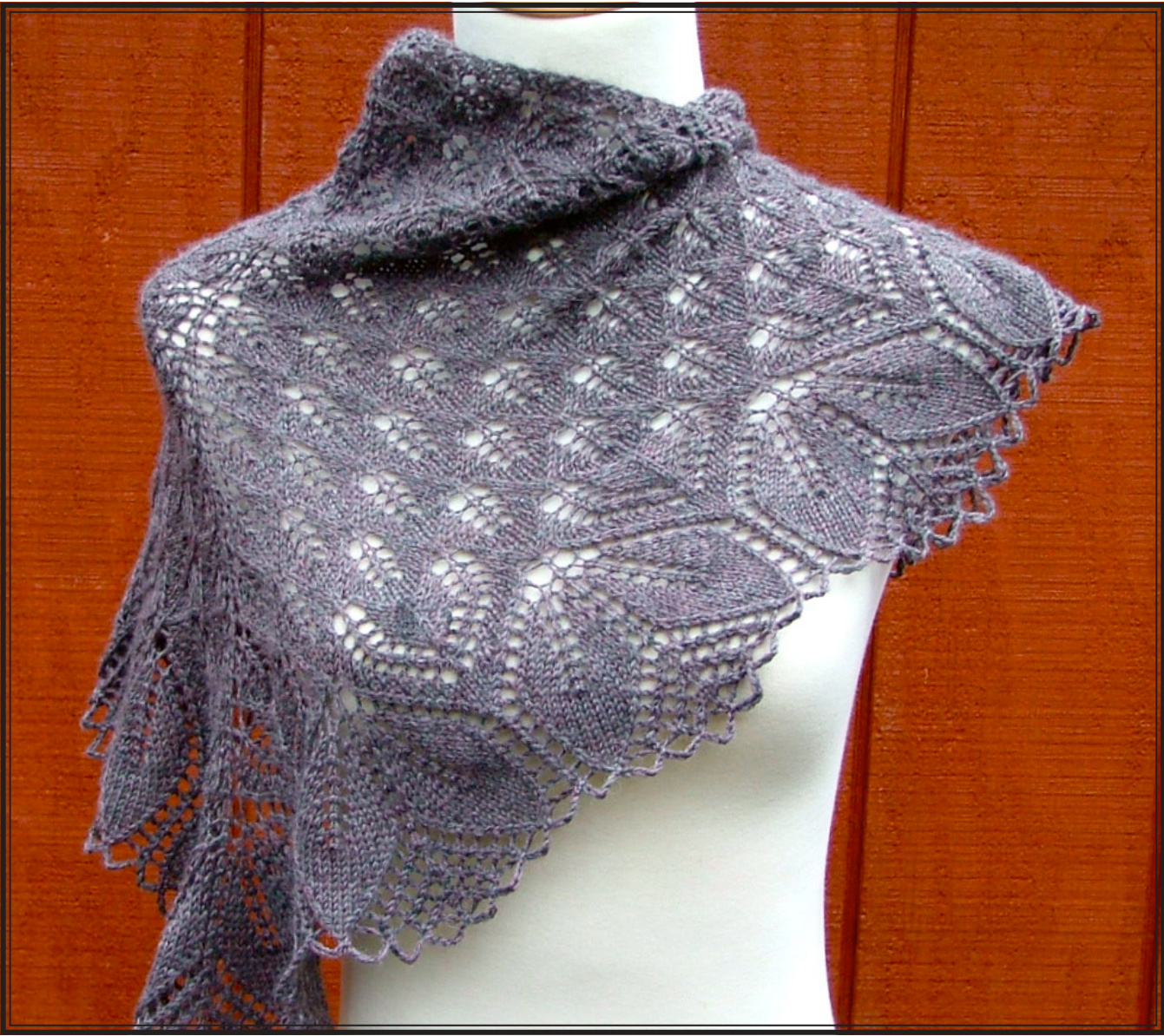Haruni
by Emily Ross January 22, 2010 Revision 2
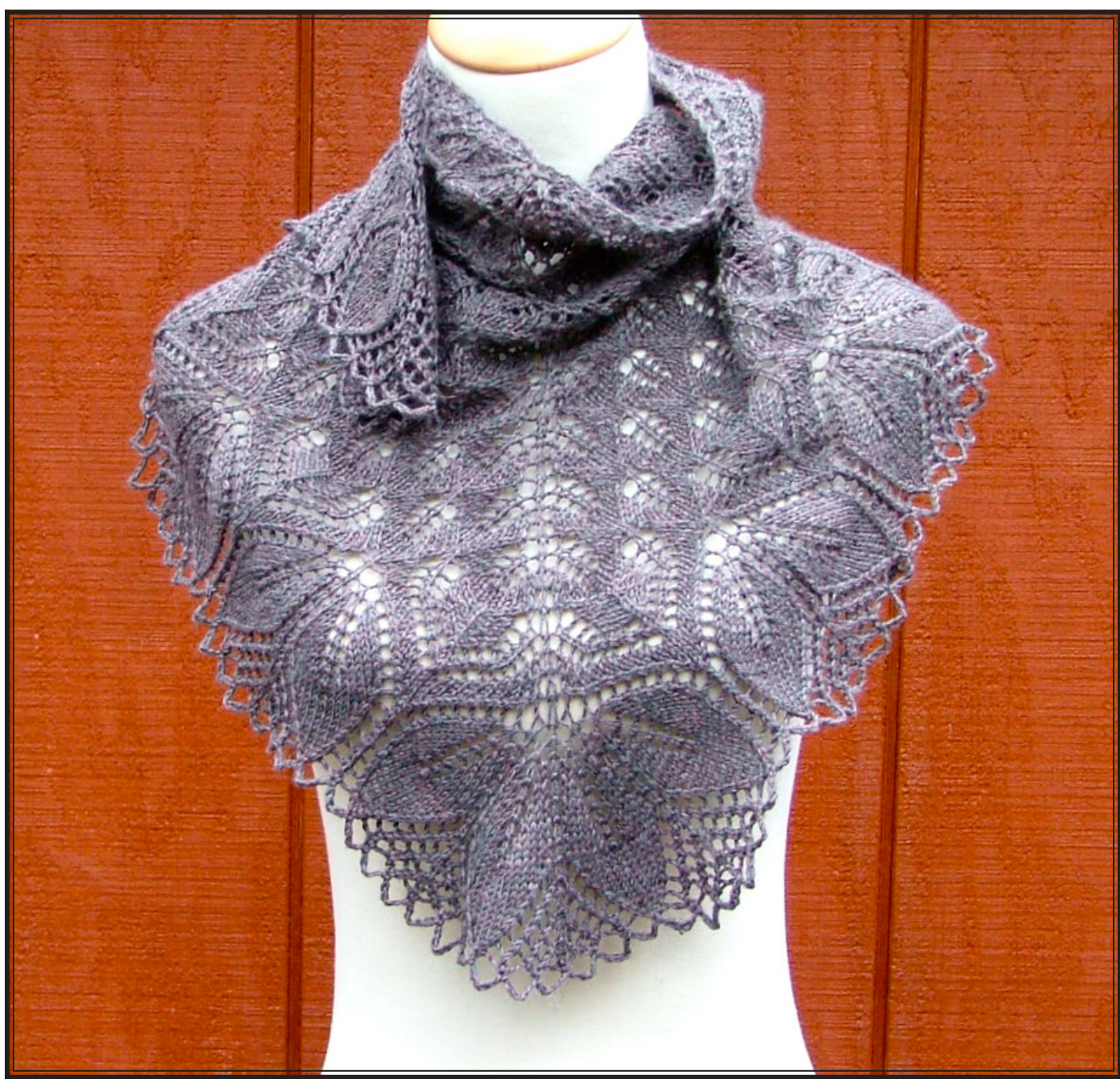
Haruni is a slightly crescent shaped triangular shawl, worked from the top down. It begins with a smaller version of the traditional fern lace motif, then transitions to an exuberantly leafy border, and is finished with a crochet cast off, with an alternate icord cast off as well. I've rated this pattern as moderately diffcult. However, if you have no experience with lace knitting, this pttern ill be considerably more callenging.
Acknowledgments
his pattern began life as a small project I made for my Grandmother simple project that a few others might enjoy, I wrote up the charts. With the help of my husband's design and layout skills we soon had a pattern ready for publishing. The initial response was overwhelming, to say the least. Thanks to the many suggestions and questions of fellow knitters I quickly learned better ways of explaining my thoughts and charting my ideas. This revision is the result of many such suggestions. I would like to thank my wonderful husband, Brian K. Ross, for his tireless work on layout, design, schematic drawing, and photography. Also many thanks to \*Haramis? for her tech editing skill, making the written directions posible. The name Haruni means “Grandmother” in Quenya, Tolkien's elven language. I've tried to make this pattern as accurate as possible, but if you fnd any errors or have questions there is extensive pattern support at Ravelry.com. If you need additional information my personal e-mail address is knitterain@me.com. Happy Knitting!
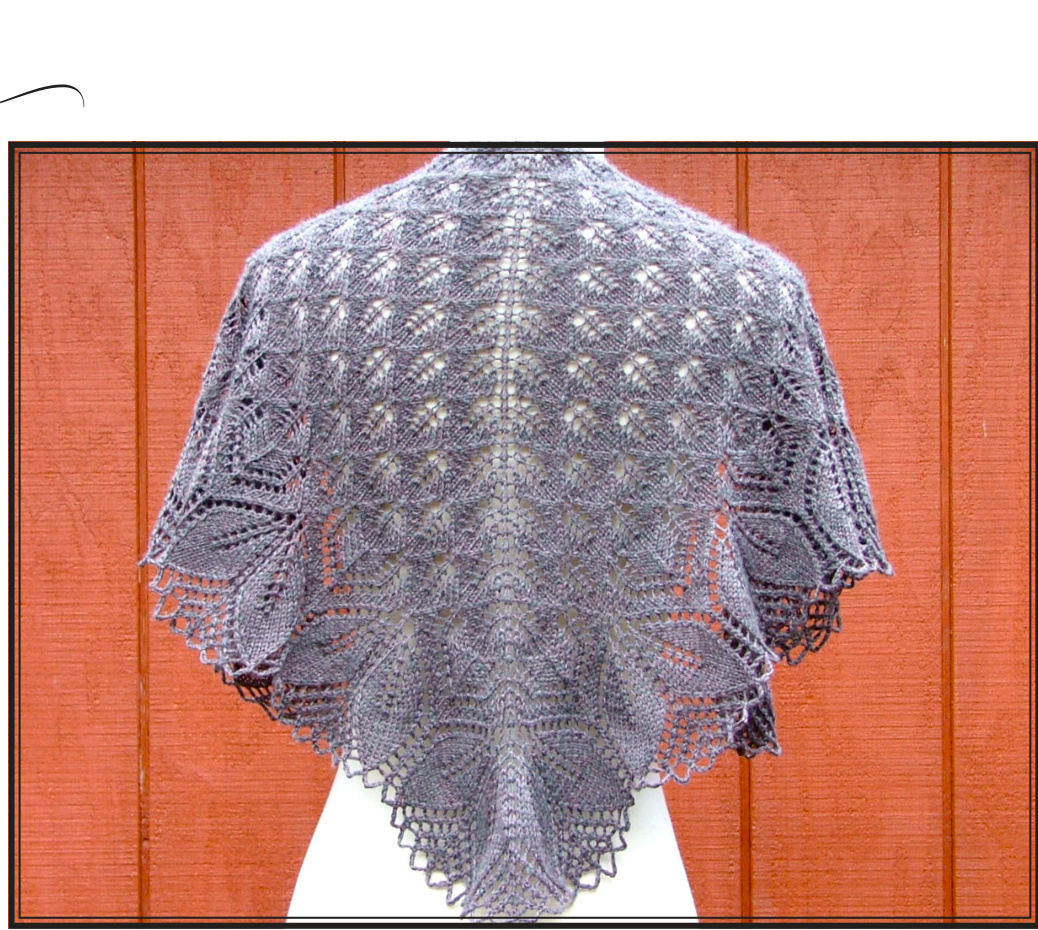
Find Emily on http://ravelry.com as “Knitterain" knitterain@me.com
Materials
Gauge
460 yards sock or fingering weight yarn. Size 4 circular needle, at least 24" long, or size needed to obtain gauge. Stitch markers 1 crochet hook. As long as it is small enough to fit between your stitches and you needle, size is unimportant. If you use the alternate icord cast off you do not need a crochet hook. Blocking pins/wires 21 stitches and $18\ \mathrm{rows}=4$ inches in lace pattern, after blocking. Like most lace patterns, gauge is not vital, you can knit this pattern in a variety of yarn weights. My finished shawl, which used 460 yards of sock yarn measures $23^{\circ}$ deep, with a wingspan of 45". You can easily adjust the size of this shawl by knitting more or less repeats of the fern pattern. Please note that any change in yarn, needle size, or number of repeats will change your yardage requirements as well.
A Construction Note
If you have experience with top down triangular shawls, this one works much the same way. If you haven't made a top down triangular shawl before,the construction can be a bit confusing. You are essntially creating one large triangle that consists of 2 identical triangles, with a single spine stitch running down the center. The shaping is achieved by increasing on each edge, as well as on either side of the center stitch. For much of the pattern you will be increasing 4 stitches per row - one on the right edge, 2 in the center, and 1 on the left edge. For some rows you increase 8 stithes. Allincreases are incorporated into the lace pattern. In Chart B the rate of increase changes, with rows 1-15 increasing quite rapidly, and the fnal 13 rows actually decreasing. Please see the schematic for more on the construction of this shawl.
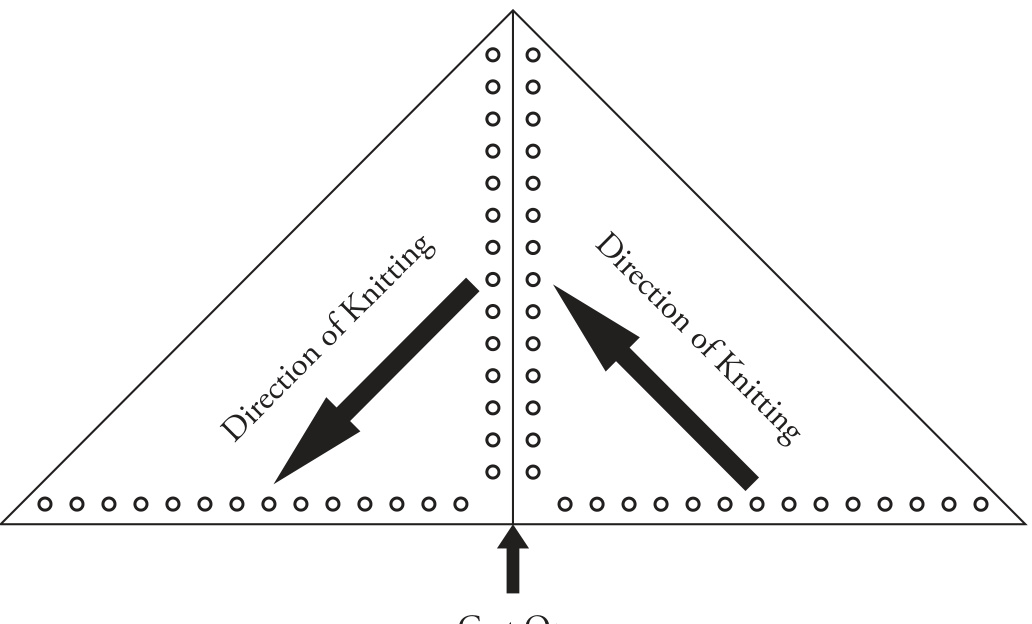
Instructions
Set Up
This shawl begins with a garter stitch tab. Using the provisional cast on method of your choice (crochet chain or waste yarn), cast on 3 stitches. Sl1, k2. This initial slipped stitch should be worked quite loosely, so that you can properly block your shawl. The slipped stitch creates an attractively smooth finish on these edge stitches. You may simply knit the first stitch of every row if you prefer. Repeat this row 5 more times. After the 6th row, rotate your knitting, and pick up 3 stitches along the side of your strip of knitting, one in each garter ridge. Pick up the 3 stitches from your provisional cast on, and you are ready to begin Chart A with 9 stitches on your needle.
Chart A
This chart only shows half of your shawl. There are also a total of 7 stitches that are not shown on this chart. The 7 stitches are your first 3, last 3, and your center stitch. To knit across an entire row, sll, k2, knit the chart as written from right to left, knit your center stitch, then repeat the chart from right to left and end k3. All even numbered rows are sl1, k2, p to the last 3, then k3. Place stitch markers before the center stitch. You may also want to add stitch markers to set offthe first and last three stitches. After row 31, repeat rows 17-31 4 more times. The yellow stitches show the pattern repeat. To knit these rows, sl1, k2, then knit the first pink stitches. Repeat the yellow stitches as many times as possible up to your center stitch, and end with the final pink stitches. Knit your center stitch, then repeat across the second half of your shawl, starting with the first pink stitches, repeating the yellow as many times as possible, ending with the final pink stitches, then your k3. After 4 repeats you will have 12 stems on each half of your shawl. The stem is the knit stitch between the vertical pair of yos. If you want to make this shawl larger or smaller, you may knit more or less repeats of this section. As you may have noticed, the pattern repeat is really only 8 rows, however, I've shown it as a 16 row repeat to make sure you always end up with an even number of stems per side. If you don't have an even number of stems, Chart B will not line up correctly. Please note that due to the rapid rate of increase in Chart B it willconsume roughly half your entire yardage.
Chart B
In Chart B you will be increasing much more rapidly for the first 15 rows, then decreasing the number of stitches per row for the final 13 rows. Like Chart A, this shows only half of the shawl. Unlike Chart A, the 3 edge stitches are charted, because they change starting on row 17. When repeating Chart B therefore, do not repeat the edge stitches. The center stitch is still uncharted. For rows 1-15 it remains as a single knit stitch. For the frst 15 rows of this chart, you will be growing pairs of leaves, while decreasing the stitches between pairs. Each half of the shawl must begin AND end with a pair of leaves, separated by your center stitch. I've highlighted these segments in yellow on the chart. To knit a fu row of Chart B, you begin reading right to left, repeating the entire chart minus the 3 edge stitches, ending your final repeat of the first half midway through the chart, with the last yellow stitch. Knit your center stitch (not shown on the chart), and repeat for the second halfof the shawl, starting AND ending with a yellow segment, and finishing with k3. If you are knitting from the charts you may want to consult the written instructions to insure you understand the repeat structure. For rows 17-27, you willbe decreasing the leaves, while only increasing between leaves, (shown in pink) NOT between sets of leaves. When you come to the 4 leaves (2 pairs) that make up the center of your shawl, knit the increase section (shown in pink) between EACH leaf. Starting with row 17, you no longer have a center stitch, you have a center section, which is shown in pink. The 3 edge stitches change starting on row 17 - the first sk will consume your yo from the previous pattern row. The fnal edge stitches will be yo, k2tog, k2, instead of k3. Also note the special stitches on row 17. The two special stitches are worked as double decreases EXCEPT for the ones on the very first and very last leaf of each half. After your final (wrong side) row, you are ready to bind off You have the option of a crochet bind off or a 2 stitch icord bind off. The icord bind off requires more yarn, and results in a less delicate loops. If you are knitting this shawl out of lace or cobweb weight yarn I sugest you either use the icord cast off or use a double strand of yarn for the crochet bind off.
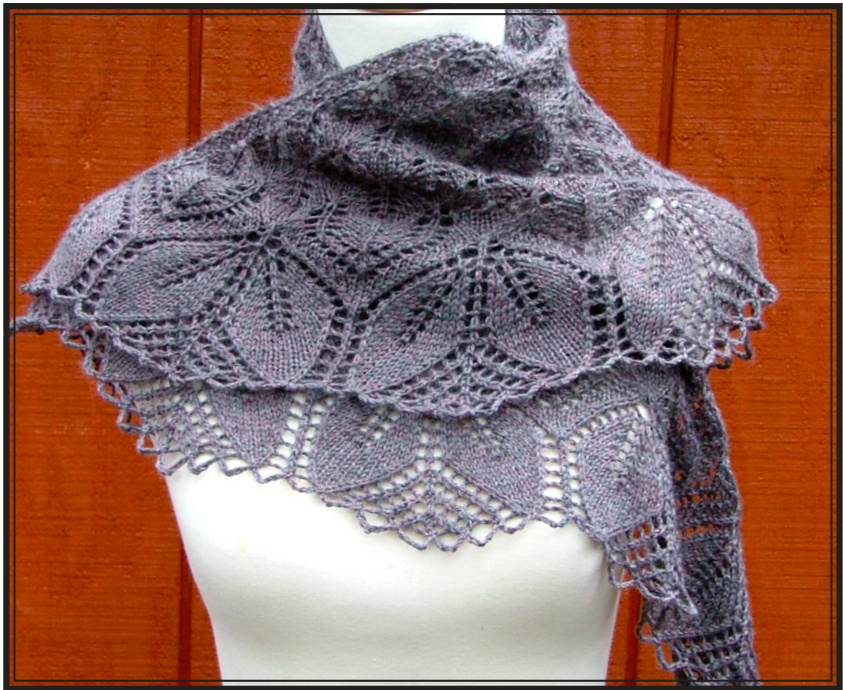
Crochet bind off
Using your crotchet hook like a knitting needle, k4tog. Single chain 6 stitches, then k3tog off your lft needle. Cast off 1 stitch by passing the frst stitch (on your crotchet hook) over the stitch you just knit. Single chain 6 stitches, then k3tog, and cast off 1. Continue in this manner, always knitting 3 stitches together. The initial k4tog was only for the edge stitches. Your k3tog should line up with the pattern, closing each leaf tip.
Icord bind off
As an alternative to the crochet cast off you can do a similar cast off using icord. Begin with k2tog, k2tog. Then without turning or twisting, slide these 2 stitches back the the left needle. Knit these same 2 stitches again. Slide them back to your left needle, and knit them again. Knit these 2 stitches a total of 8 times, creating a slender cord. Keeping the 2 stitches on your right hand needle, k3tog ofyour left hand needle, and cast off 1 stitch, by passing the middle stitch over the stitch you just knit, and off the needle. Slide the remaining 2 stitches to your left needle and $\mathrm{k}2$ .Repeat across entire shawl. The k3tog should line up with the lace pattern, closing each leaf tip. Sew in any ends, soak, and block. When blocking you can either use wires to block this into a triangular shape, or pin out the loops individually to emphasize the curves of the leaves. You can also either block the top straight across, or gently curve it into more of a crescent shape.
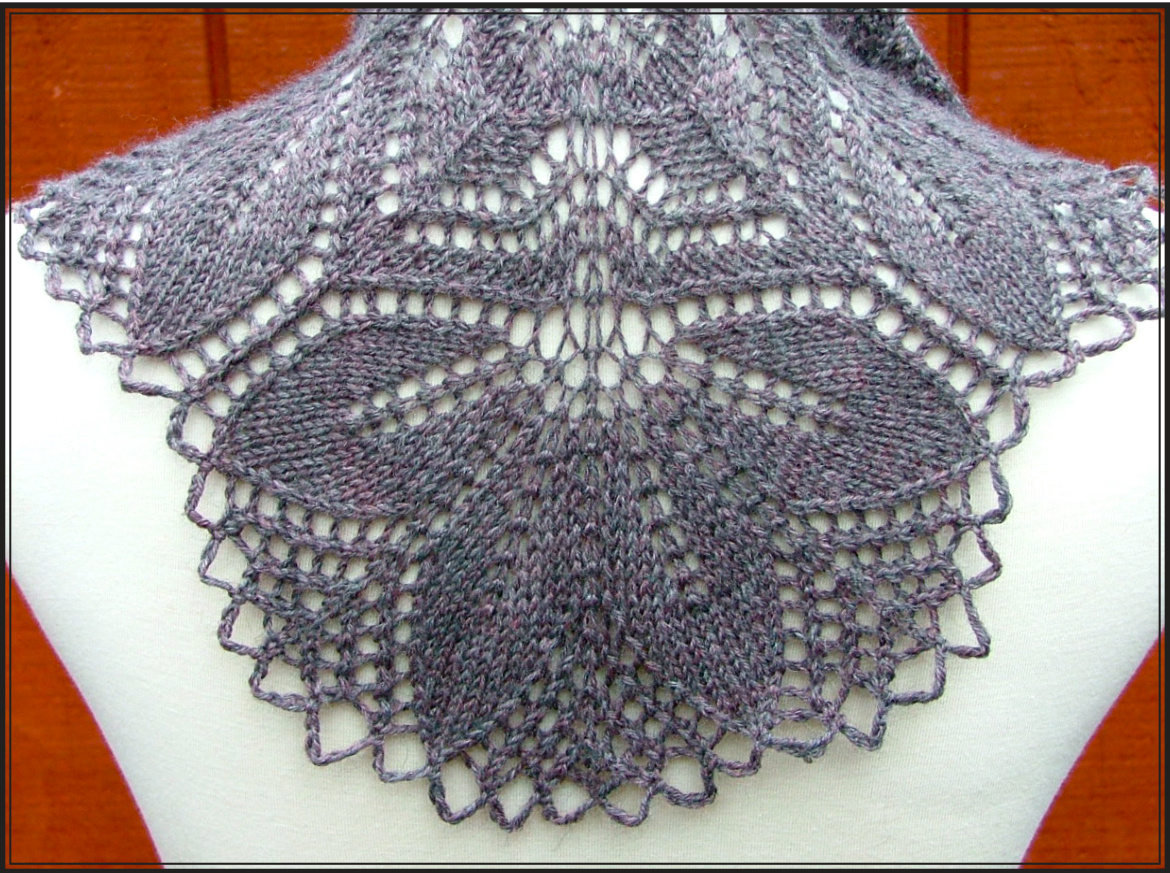
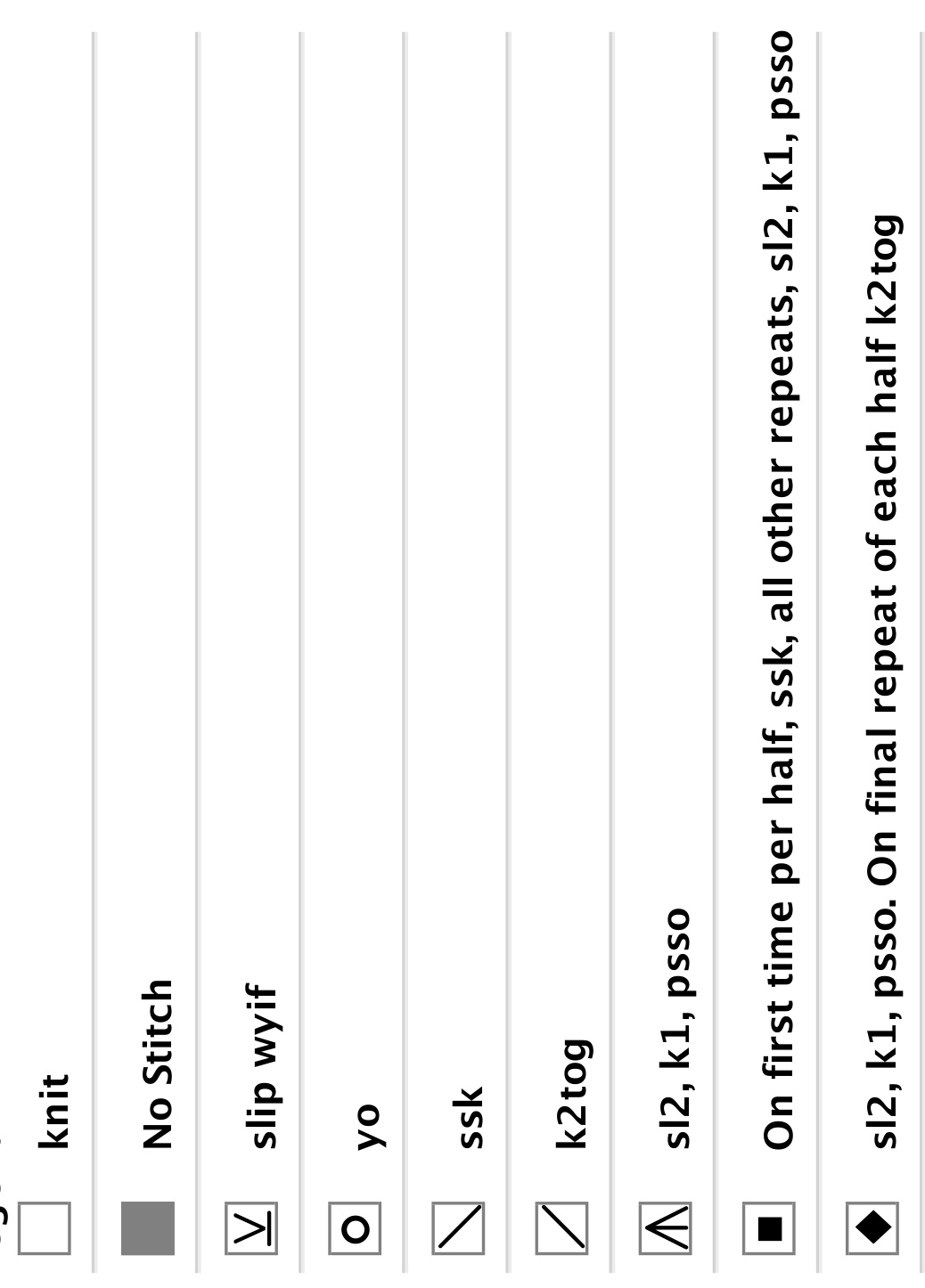
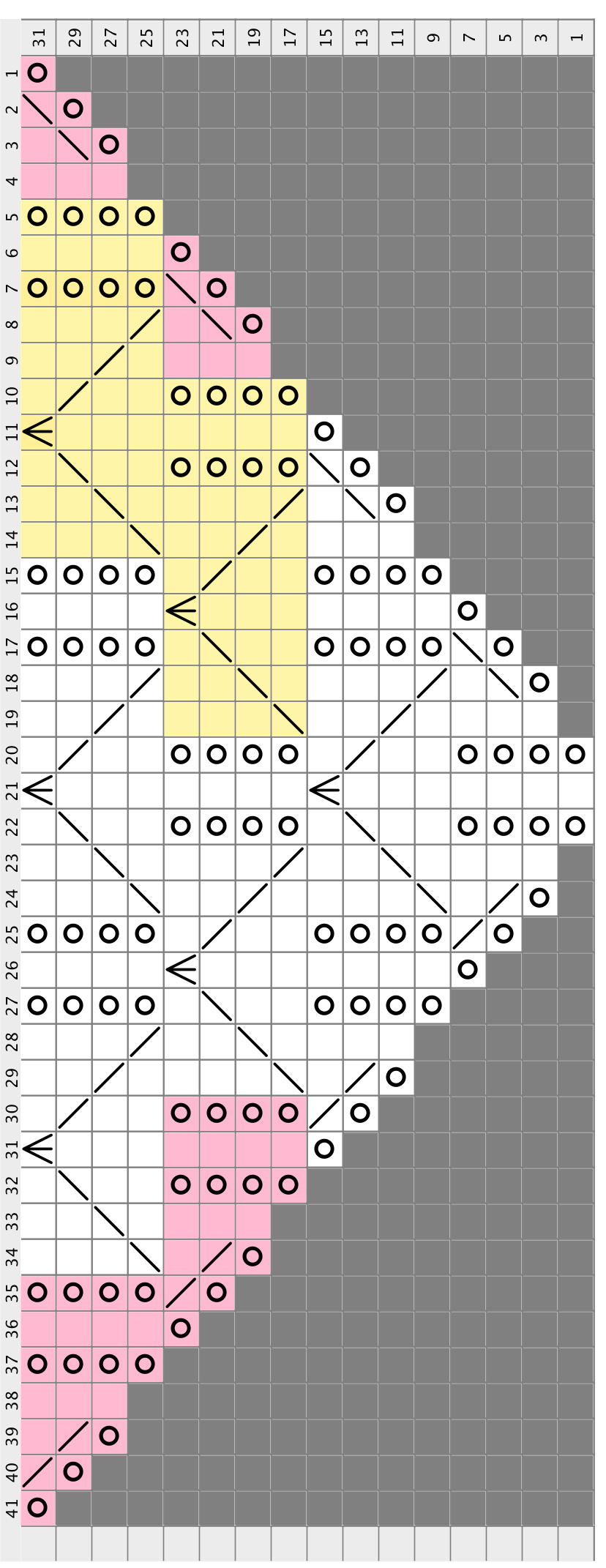

Chart A
The bold “k1" indicates your center stitch "TS" = Total Stiches per row Row 1, sll, k2, \* yo, kl, yo $^*$ , kl, repeat from $^*$ to $^*$ , k3 (13 TS) Row 2, and all even rows, sll, $\mathrm{k}2$ purl until the final 3 stitches, k3 (13 TS) Row3, sll, k2, \* yo, kl1, yo, kl,yo, $\mathrm{k}1$ yo $^*$ , k1, repeat from $^*$ 0 $^*$ ,k3 (21 TS) Row 5, sll, k2, $^*$ yo,k2tog, kl, yo, kl, yo, kl, sk, $y_{0}*,\mathbf{k}\mathbf{l}_{\cdot}$ repeat from $^*$ 00 $^*$ ,k3 (25 TS) Row 7,sll, k2, $^*$ yo,k2tog, k2, yo,kl, yo, k2, ssk, $y\mathbf{o}*\mathbf{k}\mathbf{l}$ repeat from $^{*\;\mathrm{to}\;*\;,\;\mathrm{k}3}$ (29 TS) Row 9, sl1,k2, $^*$ yo,k1, yo, ssk, k5,ktog, yo, kl, yo $^*$ , kl, repeat from $^*$ 0 $^*$ ,k3 (33 TS) Row11, s,k2,\* yo,kl,yo,kl, yo,kl, sk, k3,k2tog, kl, yo,kl, yo,kl,yo\*,kl, repeat from $^*$ to $^*$ $\mathrm{k}3$ (41 TS) Row 13, sl1, k2,\* yo,k2tog, kl, yo,klyo,k2,ssk, kl, k2tog, k2, yo,kl, yo,k, sk, $y_{0}*,\mathbf{k}\mathbf{l}$ repeat from $^*$ $^*$ ,k3(45 TS) Row 15, sll,k2, $^*$ yo,k2tog, k2,yo,kl, yo,k3,s2klpso, k3, yo,kl, yo, k2,ssk, yo $^*$ ${\bf k}{\bf1}$ repeat from $^*$ $^*$ ,k3 (49 TS) Row 17,sll, k2, $^*$ yo,kl,yo,ssk,k,ktg, yo,kl, yo, ssk, k,ktog, yo,k, y\* , ${\bf k}{\bf1}$ repeat from $^*$ to $^*$ , k3 (53 TS) Row 19, sl1, k2, $^*$ yo,k1, yo,k, yo,kl, ssk, k,ktog,kl,y,k, yo,kl, sk, k k2tog, kl, yo, kl, yo, kl, $y_{0}*,\mathbf{k}\mathbf{l}$ repeat from $^*$ $^*$ ,k3 (61 TS) Row 21, sl1, k2, $^*$ yo,k2tog,kl, yo,kl,yo,k2,ssk, k, ktog,k2,yo,kl, yo,k, ssk, k1, k2tog, k2, yo, k1, yo, kl, ssk, yo $^*$ , kl, repeat from $^*$ $^*$ ,k3 (65 TS) Row 23, sll1, k2, $^*$ yo, k2tog, k2, yo, kl, yo, k3, sl2klpsso, k3, yo, kl, yo, k3, sl2klpsso, k3, yo, k1, yo, k2, ssk, yo $^*$ , k1, repeat from $^*$ to $^*$ , k3 (69 TS) Row 25, sl1, k2, $^*$ yo,k1, yo, ssk, k,ktog, yo,k,y, ssk,k5,ktg, yo, k, y, , k5, k2tog, yo, kl, yo $^*$ , k1, repeat from $^*$ $^*$ , k3 (73 TS) Row 27, sl1, k2, $^*$ yo, kl, yo, kl, yo, kl, ssk, k3, k2tog, kl, yo, kl, yo, kl, sk, k3, k2tog, kl, yo,k1, yo, k1, ssk, k3, k2tog, kl, yo, kl, yo, k1, yo $^*$ , k1, repeat from $^*$ $^*$ , k3 (81 TS) Row29, sll, k2,\* yo,k2tog, kl, yo, kl, yo, k2, ssk, kl, ktog,k2, yo, kl, yo, k, ssk, k1, k2tog, k2, yo,kl, yo, k2, ssk, kl1, k2tog, k2, yo, kl, yo, kl, ssk, yo $^*$ ,k1, repeat from $^*$ $^*$ , k3 (85 TS) Row 31,s1, k2, $^*$ yo, k2tog, k2, yo, kl, yo, k3, sl2klpsso, k3, yo, kl, yo, k3, sl2k1psso, k3, yo, k1, yo, k3, sl2klpsso, k3, yo, kl, yo, k2, ssk, yo $^*$ , kl, repeat from $^*$ to $^*$ , k3 (89 TS) Row 33, sll, k2, $^*$ [yo, kl, yo, ssk, k5, k2tog], repeat stitches within brackets 4 times total, yo, k1, yo $^*$ , kl, repeat from $^*$ to $^*$ , k3 (93 TS) Row 35, sll, k2, $^*$ yo, k1, [yo, k1, yo, kl, ssk, k3, k2tog, k1],repeat stitches within brackets 4 times total, yo, kl, yo, k1, yo $^*$ , k1, repeat from $^*$ $^*$ ,k3 (101 TS) Row 37, sl1, k2, $^*$ yo, k2tog, kl, [yo, kl, yo, $\mathrm{k}2$ ssk, k1, k2tog, k2], repeat stitches between brackets 4 times total, yo, kl, yo, k, ssk, $y_{0}*,\mathbf{k}\mathbf{l}$ repeat from $^{*\;\mathrm{to}\;*\;,\;\mathrm{k}3}$ (105 TS) Row 39, sl1, k2, $^{\ast\,}{\mathrm{yo}}$ k2tog, k2, [yo, k1, yo, k3, sl2klpsso, k3],repeat stitches within brackets 4 times total, yo, k1, yo, k2, ssk, $y_{0}*,\mathbf{k}\mathbf{l}$ repeat from $^*$ $^*$ ,k3 (109 TS) Row 41, same as row 33, with 5 repeats of stitches between brackets (113 TS) Row 43, same as row 35, with 5 repeats of stitches between brackets (121 TS) Row 45, same as row 37, with 5 repeats of stitches between brackets (125 TS) Row 47, same as row 39, with 5 repeats of stitches between brackets (129 TS) Row 49, same as row 33, with 6 repeats of stitches between brackets (133 TS) Row 51, same as row 35, with 6 repeats of stitches between brackets (141 TS) Row 53, same as row 37, with 6 repeats of stitches between brackets (145 TS) Row 55, same as row 39, with 6 repeats of stitches between brackets (149 TS) Row 57, same as row 33, with 7 repeats of stitches between brackets (153 TS) Row 59, same as row 35, with 7 repeats of stitches between brackets (161 TS) Row 61, same as row 37, with 7 repeats of stitches between brackets (165 TS) Row 63, same as row 39, with 7 repeats of stitches between brackets (169 TS) Row 65, same as row 33, with 8 repeats of stitches between brackets (173 TS) Row 67, same as row 35, with 8 repeats of stitches between brackets (181 TS) Row 69, same as row 37, with 8 repeats of stitches between brackets (185 TS) Row 71, same as row 39, with 8 repeats of stitches between brackets (189 TS) Row 73, same as row 33, with 9 repeats of stitches between brackets (193 TS) Row 75, same as row 35, with 9 repeats of stitches between brackets (201 TS) Row 77, same as row 37, with 9 repeats of stitches between brackets (205 TS) Row 79, same as row 39, with 9 repeats of stitches between brackets (209 TS) Row 81, same as row 33, with 10 repeats of stitches between brackets (213 TS) Row 83, same as row 35, with 10 repeats of stitches between brackets (221 TS) Row 85, same as row 37, with 10 repeats of stitches between brackets (225 TS) Row 87, same as row 39, with 10 repeats of stitches between brackets (229 TS) Row 89, same as row 3, with 11 repeats of stitches between brackets (233 TS) Row 91, same as row 35, with 11 repeats of stitches between brackets (241 TS) Row 93, same as row 37, with 11 repeats of stitches between brackets (245 TS) Row 95, same as row 39, with 11 repeats of stitches between brackets (249 TS) After completing Row 96 (wrong side) you are now ready for Chart B - with 12 stems on either side of your shawl. Ifyou want to make a smallrshawl, you may stop Chart A after row 80, or for an even smaller shawl, afer row 64. For a larger shawl, you would do another 16 row repeat, with frst 12, then 13 repeats of the stitches between brackets.
Chart B
fyou did more orless repeats ofChart A, you will need to adjust the numberof repeats in Chart B. If you did 3 repeats instead of4 for a smaller shawl, repeat between the $^*$ (stars 1 lestime. Conersly, f you did 5 repeats of Chart A, then you would epeat between the $^*$ (stars) I more time. The bold “k1”" indicates your center stitch "TS" = Total Stiches per row Row 1, sll, $\mathrm{k}2,\mathrm{*}\,\mathrm{y}0,\mathrm{k}]$ 1, yo, sk, k2, yo, ssk,yo,k2, sl2klpso, k2, yo, k2tog, yo, k2 $\mathrm{k}2\mathrm{tog\ast}$ , knit from $^*$ 0 $*\ 5$ more times, yo, kl, yo, kl, knit from $^*$ .0 $*\ 6$ times, yo, k1, yo, k3 (253 TS) Row 3, sll, k2, $^*$ yo, kl, yo, kl, yo, $\mathrm{k}1$ yo, ssk, k2, yo, ssk, yo, kl,sl2k1psso, kl, yo, $\mathrm{k}2$ tog, yo, k2, k2tog $^*$ , knit from $*\mathrm{~to~}*5$ more times, yo, kl, yo, kl, yo, kl, yo, k1, knit from $*\mathrm{~to~}*6$ times, yo, $\mathrm{k}1$ yo, k1, yo, kl, yo, k3 (285 TS) Row 5, sll, k2, $^*$ yo,kl, yo, kl, yo, kl, yo, kl, yo, kl, yo, kl, yo, kl, yo, ssk, k2, yo, ssk, yo, sl2klpsso, yo, k2tog, yo, k2, k2tog $^*$ , knit from $^*$ 0 $*\ 5$ more times, yo, k1, yo, kl, yo, kl, yo, kl, yo, kl, yo, kl, yo, kl, yo, kl, knit from $*\mathrm{~to~}*6$ times, yo, kl, yo, kl, yo, kl, yo, kl, yo, kl, yo, kl, yo, k1, yo, k3 (373 TS) Row 7,sll, k2, $^*$ yo, k2tog, kl, yo, kl, yo, kl, ssk, yo, kl, yo, k2tog, kl, yo, kl, yo, k1, ssk, yo, sk, k2, yo, sk, kl, k2tog, yo, k2, k2tog $^*$ , knit from $*\mathrm{~to~}*5$ more times, yo, k2tog, kl, yo, kl, yo, k1, ssk, yo, kl, yo, k2tog, kl, yo, kl, yo, kl, ssk, yo, ${\bf k1}$ , knit from $^*$ 0 $\ast\mathit{6}$ times, yo, k2tog, kl1, yo, kl1, yo, kl1, sk, yo, kl, yo, k2tog, k1, yo, $\mathrm{k}1$ yo, k1, ssk, yo, k3 (405 TS) Row 9, sll, k2, $^*$ yo, k2tog, k2, yo, kl, yo, k2, sk, yo, kl, yo, k2tog, k2, yo, kl, yo, $\mathrm{k}2$ , ssk,yo, ssk, k2, yo, sl2k1psso, yo, k2, k2tog $^*$ , knit from $^*$ 0. $*\ 5$ more times, yo, k2tog, k2, yo, kl, yo, k2, ssk, yo, k1, yo, k2tog, k2, yo, kl, yo, k2, ssk, yo, ${\bf k1}$ knit from $^*$ 10 $\ast\mathit{6}$ times, yo, k2tog, k2, yo, kl, yo, k2, ssk, yo, k1, yo, k2tog, k2, yo, kl, yo, k2, ssk, yo, k3 (437 TS) Row 11, sll, k2, $^*$ yo, k2tog, k3, yo, kl, yo, k3, ssk, yo, k1, yo, k2tog, k3, yo, kl, yo, k3, ssk, yo, ssk, k5, k2tog $^*$ , knit from $^*$ 0 $*\ 5$ more times, yo, k2tog, k3, yo, kl, yo, k3, ssk, yo, kl, yo, k2tog, k3, yo, kl, yo, k3, ssk, yo, k1, knit from $*\mathrm{~to~}*6$ times, yo, k2tog, k3, yo, kl, yo, k3, ssk, yo, kl, yo, k2tog, k3, yo,k1, yo, k3, ssk, yo,k3 (469 TS) Row 13, sll, k2, $^*$ yo, k2tog, k4, yo, kl, yo, $\mathrm{k4}$ sk, yo,kl, yo,ktog,k4, yo,kl, yo, k4, ssk, yo, ssk, k3, k2tog $^*$ knit from $^*$ 0 $*\ 5$ more times, yo, k2tog. $\mathrm{k4}$ yo, kl, yo, k4, ssk, yo, kl, yo, k2tog, k4, yo, $\mathrm{k}1$ yo, $\mathrm{k4}$ , ssk, yo, k1, knit from $*\mathrm{~to~}*6$ times, yo, k2tog, k4, yo, kl, yo, k4, ssk, yo, $\mathrm{k}1$ yo, k2tog, $\mathrm{k4}$ yo, $\mathrm{k}1$ yo, $\mathrm{k4}$ . ssk, yo, k3 (501 TS) Row 15, sl1, k2, $^*$ yo, k2tog, k5, yo, kl, yo, k5, ssk, yo, kl, yo, k2tog, k5, yo, kl, yo, k5, ssk, yo,sk, kl, ktog $^*$ knit from $^*$ 0 $*\ 5$ more times, yo, k2tog, k5, yo, kl, yo, k5, ssk, yo, kl, yo, k2tog, k5, yo, kl, yo, k5, ssk, yo, kl, knit from $^*$ 0 $\ast\mathit{6}$ times, yo, k2tog, k5, yo, k1, yo, k5, ssk, yo, kl, yo, k2tog, k5, yo, k1, yo, k5, ssk, yo, k3 (533 TS) Beginning on row 17, you no longer ave a centerstitch, ut a center section. This entir section is in bold. Row 17, s1, k, ssk, yo, ssk, k11, k2tog, yo, k3, yo, ssk, kll, sl2kpsso, yo, sl2klpso, yo, $^*$ sl2klpsso, k1l1, k2tog, yo, k3, yo, ssk, k11,sl2klpsso, yo, sl2k1psso, yo $^*$ knit from $^*$ $\ast\mathrm{~4~}$ more times, sl2kl1psso, kl1, k2tog, yo, k3, yo, ssk, kl1, k2tog, yo, k3, yo, sk, kl1, k2tog, yo, k3, yo, ssk, k11, sl2klpsso, yo, sl2klpsso, yo, knit from $^*$ 00 $*\ 5$ times, sl2klpsso, k11, k2tog, yo, k3, yo, ssk, k11, k2tog, yo, k2tog, k2 (483 TS) Row 19, sl1, kl,sk, yo, $^*$ ssk, $\mathrm{k9}$ k2tog, yo, ktog yo,kl, yo, ssk, yo, sk, k9, ktog. yo, sl2k 1psso, yo $^*$ knit from $^*$ 0 $*\ 5$ more times, sk, k9, k2tog, yo, k2tog, yo, kl, yo, ssk, yo, ssk, k9, k2tog, yo, k2tog, yo, ${\bf k1}$ yo, ssk, yo, knit from $^*$ 10 $\ast\mathit{6}$ times, ssk, $\mathrm{k9}$ k2tog, yo, k2tog, yo, kl, yo, sk, yo, ssk, k9, k2tog, yo, k2tog, k2 (457 TS) Row 21, sl1, kl1, ssk, yo, $^*$ ssk, k7, k2tog, yo, k2tog, yo, k3, yo, ssk, yo, ssk, k7, k2tog. yo, sl2k1psso, yo $^*$ knit from $^*$ 10 $*\ 5$ more times, ssk, k7, k2tog, yo, k2tog, yo, k3, yo, ssk, yo, ssk, k7, k2tog, yo, k2tog, yo, k3, yo, ssk, yo, knit from $*\mathrm{~to~}*6$ times, ssk, $^{\mathrm{k7,}}$ k2tog, yo, k2tog, yo, k3, yo, ssk, yo, ssk, k7, k2tog, yo, k2tog, k2 (431 TS) Row 23, sl1, kl,sk, yo, $^*$ ssk, k5, k2tog, yo, k2tog, yo, k2tog, yo, kl, yo, ssk, yo, ssk, yo, ssk, k5, k2tog, yo, s2k1psso, yo $^*$ , knit from $^*$ $*\ 5$ more times, sk, k5, k2tog, yo, k2tog, yo, k2tog, yo, k1, yo, ssk, yo, ssk, yo, ssk, k5, k2tog, yo, k2tog, yo, k2tog. yo, kl, yo,ssk, yo, sk, yo, knit from $^*$ 0 $\ast\mathit{6}$ times,sk, $^{\,\mathrm{k}5}$ ,k2tog, yo, k2tog, yo, k2tog, yo, kl1, yo,ssk, yo, ssk, yo, ssk, k5, k2tog, yo, k2tog, k2 (405 TS) Row 25, sl1, kl1, ssk, yo, $^*$ ssk, k3, k2tog, yo, k2tog, yo, k2tog, yo, k3, yo, ssk, yo, ssk, yo, ssk, k3, k2tog, yo, sl2k1psso, yo $^*$ , knit from $^*$ 0 $*\ 5$ more times, ssk, k3, k2tog, yo, k2tog, yo, k2tog, yo, k3, yo, sk, yo, sk, yo, ssk, k3, k2tog, yo, k2tog, yo, k2tog, yo, k3, yo,ssk, yo,ssk, yo, knit from $^*$ 101 $\ast\mathit{6}$ times, ssk, k,ktog, yo,ktg, y, k2tog, yo, k3, yo, ssk, yo, ssk, yo, ssk, k3, k2tog, yo, k2tog, k2 (379 TS) Row 27,sl1, kl,sk, yo, $^*$ ssk, k1, k2tog, yo, k2tog, yo, k2tog, yo, k2tog, yo, kl, yo, ssk, yo, sk, yo, ssk, yo, ssk, k1, k2tog, yo, s2kl1psso, yo $^*$ , knit from $^*$ 0 $*\ 5$ more times, sk, kl, ktog, yo, ktog, yo, k2tog, yo, k2tog, yo, kl, yo, ssk, yo, ssk, yo, ssk, yo, sk, kl, k2tog, yo, k2tog, yo, k2tog, yo, k2tog, yo, kl, yo, ssk, yo, ssk, yo, ssk, yo, knit from $^*$ 0 $\ast\mathit{6}$ times, ssk, kl1, k2tog, yo, k2tog, yo, k2tog, yo, k2tog, yo, kl, yo, ssk, yo, ssk, yo, ssk, yo, ssk, k1, k2tog, yo, k2tog, k2 (353 TS)
